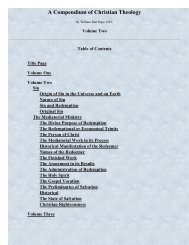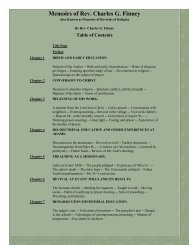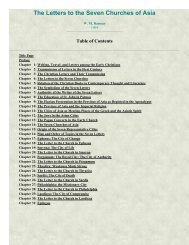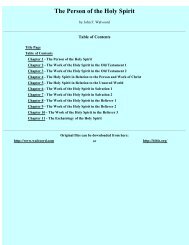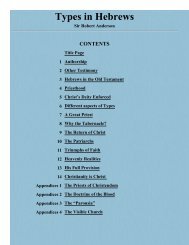- Page 1 and 2: Title Page Preface The History of R
- Page 3 and 4: The History of Rome By Titus Livius
- Page 6 and 7: The History of Rome By Titus Livius
- Page 8 and 9: afterwards called Inuus. The existe
- Page 10 and 11: cities, and his people supported hi
- Page 12 and 13: T. Tatius. The origin of the Lucere
- Page 14 and 15: the City, Numa ordered that in his
- Page 16 and 17: two kindred and neighbouring people
- Page 18 and 19: entrusted the fortunes of the State
- Page 20 and 21: solemnities they had consigned to o
- Page 22 and 23: his wife's side in the carriage, th
- Page 26 and 27: space which the Etruscans of old, w
- Page 28 and 29: ears, for they call it the Vicus Sc
- Page 30 and 31: with sufficient spirit to take up a
- Page 32 and 33: guests. When all around seemed safe
- Page 34 and 35: The History of Rome By Titus Livius
- Page 36 and 37: askets to the Tiber and threw it in
- Page 38 and 39: could bear the burden; the poor wer
- Page 40 and 41: y the hostages themselves, since th
- Page 42 and 43: to the Lake Regillus in the distric
- Page 44 and 45: opinion showed itself not only amon
- Page 46 and 47: the names of those liable to active
- Page 48 and 49: without any commander in a regularl
- Page 50 and 51: epetition was that early in the mor
- Page 52 and 53: fortune of Rome destroyed the two a
- Page 54 and 55: vanquished Aequi, the standards wer
- Page 56 and 57: then when they found that they were
- Page 58 and 59: completely had the popular sentimen
- Page 60 and 61: [2.57]With difficulty Quinctius suc
- Page 62 and 63: was hastily summoned, and the consu
- Page 64 and 65: The History of Rome By Titus Livius
- Page 66 and 67: able to attack the Romans from many
- Page 68 and 69: Terentilius Harsa was a tribune of
- Page 70 and 71: merits again, for fear of aggravati
- Page 72 and 73: pointed out the seriousness of the
- Page 74 and 75:
people from this lawlessness. As to
- Page 76 and 77:
used to cultivate a four-acre field
- Page 78 and 79:
Cicero, plebeian tribune, and Vetur
- Page 80 and 81:
interfere with each other's sentenc
- Page 82 and 83:
the decemvir, who had been purposel
- Page 84 and 85:
her father to whom her master need
- Page 86 and 87:
still more the weapon still clenche
- Page 88 and 89:
aware of the fate that is hanging o
- Page 90 and 91:
names, but a large part of the levy
- Page 92 and 93:
after summoning the soldiers to an
- Page 94 and 95:
up by insubordination; Rome was no
- Page 96 and 97:
moment, attacked as they were in fr
- Page 98 and 99:
The History of Rome By Titus Livius
- Page 100 and 101:
created. Within the last ten years
- Page 102 and 103:
the equestrian order; the power of
- Page 104 and 105:
to the Government. By cutting down
- Page 106 and 107:
more to the heinous crime with whic
- Page 108 and 109:
into surrender was abandoned. As it
- Page 110 and 111:
the Dictator's orders most zealousl
- Page 112 and 113:
views, they gave the enemy his oppo
- Page 114 and 115:
honour might be expected. There was
- Page 116 and 117:
where is Caius Sempronius? where ar
- Page 118 and 119:
manner. After she had been remanded
- Page 120 and 121:
the destruction of their farm build
- Page 122 and 123:
The army was marched to the citadel
- Page 124 and 125:
[4.58]During this year the armistic
- Page 126 and 127:
The History of Rome By Titus Livius
- Page 128 and 129:
ambassadors in violation of the law
- Page 130 and 131:
weakened through the absence of men
- Page 132 and 133:
each, in spite of Sergius' attempt
- Page 134 and 135:
lockaded; against the Aequi at Labi
- Page 136 and 137:
favour of heaven, his own generalsh
- Page 138 and 139:
when the splendid city of Veii and
- Page 140 and 141:
acquired. That year the supreme mag
- Page 142 and 143:
taken of this, partly owing to the
- Page 144 and 145:
ordinary campaigns, they even made
- Page 146 and 147:
the porticoes of their mansions, no
- Page 148 and 149:
Frightful risk would have to be inc
- Page 150 and 151:
[5.51]"So painful to me, Quirites,
- Page 152 and 153:
City, with its bracing hills, its c
- Page 154 and 155:
placed in separate centuries after
- Page 156 and 157:
possible for him to show still grea
- Page 158 and 159:
justifiable ground for war, but the
- Page 160 and 161:
light, the debts of the plebs could
- Page 162 and 163:
on your patrons as clients will now
- Page 164 and 165:
Cornelius Maluginensis, Q. Serviliu
- Page 166 and 167:
standing open and all kinds of thin
- Page 168 and 169:
two Manlii took precedence of the p
- Page 170 and 171:
father happened to see her whilst s
- Page 172 and 173:
same violent conduct by which you o
- Page 174 and 175:
who would withdraw himself from you
- Page 176 and 177:
The History of Rome By Titus Livius
- Page 178 and 179:
project which, though natural to an
- Page 180 and 181:
Dictator proclaimed a suspension of
- Page 182 and 183:
you to allow us to amend our fault
- Page 184 and 185:
for being terrified by conjuring tr
- Page 186 and 187:
ordered L. Cornelius Scipio, the in
- Page 188 and 189:
300 horse. In these days the streng
- Page 190 and 191:
after being defeated on Sidicine te
- Page 192 and 193:
men must not only go into action in
- Page 194 and 195:
pass over to the right." [7.36]All
- Page 196 and 197:
One cohort, which was stationed not
- Page 198 and 199:
The History of Rome By Titus Livius
- Page 200 and 201:
to say it not only in the ears of t
- Page 202 and 203:
into battle for the final contest,
- Page 204 and 205:
hastati and principes killed; the c
- Page 206 and 207:
[8.15]C. Sulpicius Longus and P. Ae
- Page 208 and 209:
Privernum, trusting to stone walls
- Page 210 and 211:
een raised as to whether the proper
- Page 212 and 213:
unscrupulousness rather than for th
- Page 214 and 215:
splendour of his success, he will t
- Page 216 and 217:
of commanders or the auspices under
- Page 218 and 219:
maintained so equally on both sides
- Page 220 and 221:
The History of Rome By Titus Livius
- Page 222 and 223:
Then followed a long silence. The c
- Page 224 and 225:
the capitulation of Caudium. Publil
- Page 226 and 227:
to give, nor shall we have any reas
- Page 228 and 229:
the noblest families in Rome. [9.15
- Page 230 and 231:
[9.18]I am speaking of Alexander as
- Page 232 and 233:
abandoned all hope of saving Saticu
- Page 234 and 235:
they had been engaged in an interne
- Page 236 and 237:
made there were twelve branches of
- Page 238 and 239:
law might be binding in the case of
- Page 240 and 241:
prey themselves. After putting them
- Page 242 and 243:
white linen. The latter were assign
- Page 244 and 245:
complete armies were raised against
- Page 246 and 247:
[9.46]It was during this year that
- Page 248 and 249:
Veneti, and, hemmed in between the
- Page 250 and 251:
[10.7]Appius Claudius and P. Decius
- Page 252 and 253:
wheeling his horse round in some ca
- Page 254 and 255:
the Samnites, who were now pressing
- Page 256 and 257:
[10.19]As the consuls were parting
- Page 258 and 259:
people would, he felt certain, fall
- Page 260 and 261:
ecame more healthy and active by fr
- Page 262 and 263:
manifold death, the place of my des
- Page 264 and 265:
[10.33]The consul roused by the tum
- Page 266 and 267:
with favour on the Romans, so easil
- Page 268 and 269:
to man to form any conjecture as to
- Page 270 and 271:
issued for scaling ladders to be re
- Page 272 and 273:
[10.47]The year having now expired,
- Page 274 and 275:
military training. Are we afraid th
- Page 276 and 277:
the space between the ruined wall a
- Page 278 and 279:
conditions. At that time he was one
- Page 280 and 281:
senate or by order of your Assembly
- Page 282 and 283:
ack to their homes more than 7000 m
- Page 284 and 285:
same breadth but only 100 feet long
- Page 286 and 287:
struggling with the difficulties of
- Page 288 and 289:
whilst they were recovering from th
- Page 290 and 291:
"Do not think because the war, bein
- Page 292 and 293:
for, the enemy slipped out of their
- Page 294 and 295:
elections, and the fear that the wa
- Page 296 and 297:
arms in obedience to orders, when i
- Page 298 and 299:
[21.63]One of the consuls elect was
- Page 300 and 301:
[22.2]While the consul was occupied
- Page 302 and 303:
lind men over cliff and defile, men
- Page 304 and 305:
districts, whose private interests
- Page 306 and 307:
cowards call caution." Minucius sai
- Page 308 and 309:
Hardly were all on board, when some
- Page 310 and 311:
two and a half pounds of silver for
- Page 312 and 313:
[22.28]Nothing that was going on am
- Page 314 and 315:
[22.33]About the same time a Cartha
- Page 316 and 317:
weapon, to strike an enemy, or to s
- Page 318 and 319:
was intended to do, this report onl
- Page 320 and 321:
acks as though they were deserters,
- Page 322 and 323:
seaward with the intention of aband
- Page 324 and 325:
oath to return. They were accompani
- Page 326 and 327:
themselves to their fatherland." [2
- Page 328 and 329:
[23.3]Next, he called an assembly o
- Page 330 and 331:
Magius sent a spirited refusal; Han
- Page 332 and 333:
grateful and public thanksgivings o
- Page 334 and 335:
undergone in defence of the safety
- Page 336 and 337:
garrison to the extremity of want.
- Page 338 and 339:
take the people out of the Forum to
- Page 340 and 341:
[23.28]Although this despatch made
- Page 342 and 343:
case of the three hundred Campanian
- Page 344 and 345:
Carthaginians. Although the Cumans
- Page 346 and 347:
under the direction of T. Manlius.
- Page 348 and 349:
[23.44]Herennius Bassus briefly rep
- Page 350 and 351:
not stand by its own resources. Aft
- Page 352 and 353:
In Croto there was neither unity of
- Page 354 and 355:
[24.7]But everything was hurrying h
- Page 356 and 357:
there. These portents were expiated
- Page 358 and 359:
their heels and commenced a fresh b
- Page 360 and 361:
[24.20]Just at the time when the co
- Page 362 and 363:
audience of the senate. They declar
- Page 364 and 365:
state of great excitement to preven
- Page 366 and 367:
excited by the false intelligence.
- Page 368 and 369:
[24.37]Other cities took courage fr
- Page 370 and 371:
[24.41]The fighting went on in Spai
- Page 372 and 373:
and a search was commenced, rumours
- Page 375 and 376:
The History of Rome By Titus Livius
- Page 377 and 378:
forcible seizure of a position in t
- Page 379 and 380:
As soon as it was light their fligh
- Page 381 and 382:
mouth of the harbour, those who hel
- Page 383 and 384:
Beneventum for that day, and on the
- Page 385 and 386:
shut in by forest and mountain, exc
- Page 387 and 388:
seceded to him, had at first conduc
- Page 389 and 390:
great disaster that had befallen th
- Page 391 and 392:
[25.28]When the news of what had ha
- Page 393 and 394:
y arms. This summer the Roman comma
- Page 395 and 396:
their death was as great throughout
- Page 397 and 398:
where they were met by the cohort a
- Page 399 and 400:
The History of Rome By Titus Livius
- Page 401 and 402:
Young men of exceptional speed and
- Page 403 and 404:
scared by Hannibal and marched up a
- Page 405 and 406:
was nothing done for the public saf
- Page 407 and 408:
eheaded. Then putting spurs to his
- Page 409 and 410:
Scipio won people's admiration not
- Page 411 and 412:
the Carthaginians, M. Valerius Laev
- Page 413 and 414:
there are a large body of Sicilians
- Page 415 and 416:
Moericus, rather than let the leade
- Page 417 and 418:
etain their liberty, except those w
- Page 419 and 420:
[26.39]During this period the priva
- Page 421 and 422:
Anio and the walls of Rome, and the
- Page 423 and 424:
Scipio ordered fresh troops to take
- Page 425 and 426:
ut it is for others that I am anxio
- Page 427 and 428:
The History of Rome By Titus Livius
- Page 429 and 430:
leaped out of the sea like sporting
- Page 431 and 432:
humiliating conditions as the defea
- Page 433 and 434:
citadel of Tarentum. The rest was m
- Page 435 and 436:
his men and mark how they bore them
- Page 437 and 438:
equal proportion, he realised that
- Page 439 and 440:
[27.22]It was now the eleventh year
- Page 441 and 442:
marching on without reconnoitring,
- Page 443 and 444:
meet him in the field and remained
- Page 445 and 446:
neglected hair and beard, his whole
- Page 447 and 448:
appear before the senate and state,
- Page 449 and 450:
standing on the side of the camp fa
- Page 451 and 452:
the one close at hand. That one doe
- Page 453 and 454:
their army were safe, than he haste
- Page 455 and 456:
hopeful of bringing the war to a te
- Page 457 and 458:
[28.7]The beacon fires at Oreus had
- Page 459 and 460:
[28.10]The time was approaching for
- Page 461 and 462:
time remained undecided. But when t
- Page 463 and 464:
the presents, and, as he saw that t
- Page 465 and 466:
usually take them - slaves and men
- Page 467 and 468:
mutiny was thus at a standstill, de
- Page 469 and 470:
make Sucro your permanent abode? If
- Page 471 and 472:
men, was, he assured them, more of
- Page 473 and 474:
took them to that part of the city
- Page 475 and 476:
understand, however, how Africa can
- Page 477 and 478:
with your own safety. I hold the vi
- Page 479:
consul would not require, and the o
- Page 482 and 483:
mob of raw recruits. Never again wo
- Page 484 and 485:
near Ariminum, to defend Italy. [29
- Page 486 and 487:
stated that both he and his army we
- Page 488 and 489:
great and good men in the State the
- Page 490 and 491:
[29.18]"There is one matter about w
- Page 492 and 493:
The praetor's next business was to
- Page 494 and 495:
Cato, who was quaestor at the time,
- Page 496 and 497:
to him after the king's death, and
- Page 498 and 499:
galloped out fell into Masinissa's
- Page 500 and 501:
Capitol by the curule aediles, C. L
- Page 502 and 503:
[30.3]When this business was comple
- Page 504 and 505:
attle. The Roman commander drew up
- Page 506 and 507:
As he was entering the vestibule, o
- Page 508 and 509:
pardon for a city which had been tw
- Page 510 and 511:
[30.20]It is said that he gnashed h
- Page 512 and 513:
observe, but even the law of nation
- Page 514 and 515:
your lot to put an end to a war whi
- Page 516 and 517:
Different words of encouragement we
- Page 518 and 519:
seized during the previous truce we
- Page 520 and 521:
of the republic for the year. [30.4
- Page 522 and 523:
led in the procession. Q. Terentius
- Page 524 and 525:
take over the fleet which Cn. Octav
- Page 526 and 527:
[31.9]In the midst of these prepara
- Page 528 and 529:
everywhere for sale and they wanted
- Page 530 and 531:
[31.19]The envoys who had been sent
- Page 532 and 533:
cohort, sallied forth. As soon as h
- Page 534 and 535:
governor manages their meetings; it
- Page 536 and 537:
He formed a standing camp at Lyncus
- Page 538 and 539:
his standing camp. As he wanted to
- Page 540 and 541:
which occurred subsequently gave hi
- Page 542 and 543:
personal grounds. The older members
- Page 544 and 545:
The History of Rome By Titus Livius
- Page 546 and 547:
een debated for several days when a
- Page 548 and 549:
[32.11]At this juncture a shepherd
- Page 550 and 551:
of Athens. At the same time two fle
- Page 552 and 553:
should keep silence, were I only a
- Page 554 and 555:
Sicyon, the Romans on the other sid
- Page 556 and 557:
[32.28]The first business before th
- Page 558 and 559:
our allies should also be heard." T
- Page 560 and 561:
their Assembly the Argives were pou
- Page 562 and 563:
long after by Amynander with 1200 A
- Page 564 and 565:
[33.9]After the Roman troops who ha
- Page 566 and 567:
The Achaean captain-general, Nicost
- Page 568 and 569:
doing this by wasting their time in
- Page 570 and 571:
that he had fought a pitched battle
- Page 572 and 573:
this, Quinctius sent officers to th
- Page 574 and 575:
The demand of the Aetolians that Ph
- Page 576 and 577:
Bargyliae, P. Villius and L. Terent
- Page 578 and 579:
the more important question before
- Page 580 and 581:
The History of Rome By Titus Livius
- Page 582 and 583:
Do you want, Quirites, to plunge yo
- Page 584 and 585:
there is any danger of their seizin
- Page 586 and 587:
our camp is the enemy, and behind u
- Page 588 and 589:
than half a mile from the place. Le
- Page 590 and 591:
general then fixed his camp at the
- Page 592 and 593:
Carthaginians are reported to be, a
- Page 594 and 595:
esides, winter will be here, making
- Page 596 and 597:
egarded as idle and leading to no r
- Page 598 and 599:
the Gauls blocked the exits in such
- Page 600 and 601:
deliverer. [34.53]At the close of t
- Page 602 and 603:
honourable, to desire the freedom o
- Page 604 and 605:
The History of Rome By Titus Livius
- Page 606 and 607:
magistrates the senate would consen
- Page 608 and 609:
the old men and the children produc
- Page 610 and 611:
come down to him from ancient times
- Page 612 and 613:
[35.22]Just about this time the com
- Page 614 and 615:
Caryae, and on the very day he enca
- Page 616 and 617:
way. As for Quinctius, he was so an
- Page 618 and 619:
what he sees me doing; whoever hesi
- Page 620 and 621:
Q. Marcius Ralla. Many severe sente
- Page 622 and 623:
Alexander of Megalopolis, who repre
- Page 624 and 625:
The History of Rome By Titus Livius
- Page 626 and 627:
would eagerly welcome him in their
- Page 628 and 629:
walls and retreated to the interior
- Page 630 and 631:
indulgence, with the design of winn
- Page 632 and 633:
attack was made in greater force th
- Page 634 and 635:
[36.24]After suspending the operati
- Page 636 and 637:
[36.30]The booty secured round Hera
- Page 638 and 639:
them as friends or as foes. The sen
- Page 640 and 641:
itself he would have to fight by se
- Page 642 and 643:
The History of Rome By Titus Livius
- Page 644 and 645:
day, he delivered several simultane
- Page 646 and 647:
was too important a one for Pausist
- Page 648 and 649:
[37.15]This suggestion found no sup
- Page 650 and 651:
long range. After the citizens had
- Page 652 and 653:
sent a letter to Prusias the king o
- Page 654 and 655:
two ships abreast, also deployed in
- Page 656 and 657:
[37.35]A full council assembled to
- Page 658 and 659:
sixteen elephants. The line was con
- Page 660 and 661:
his conquerors. You have ever shown
- Page 662 and 663:
Albinus received the civic and alie
- Page 664 and 665:
[37.54]The king's speech gave great
- Page 666 and 667:
enough in itself to excite keen com
- Page 668 and 669:
The History of Rome By Titus Livius
- Page 670 and 671:
Nicander hit upon a bold stroke by
- Page 672 and 673:
[38.10]The consul left Ambracia for
- Page 674 and 675:
march into Pamphylia, and raised th
- Page 676 and 677:
throwing out scouting parties. Marc
- Page 678 and 679:
once in pursuit. After placing the
- Page 680 and 681:
showed great forbearance also in re
- Page 682 and 683:
All were found guilty and handed ov
- Page 684 and 685:
ecovery. Whatever cities amongst th
- Page 686 and 687:
consuls asked the senate to settle
- Page 688 and 689:
people of Rome had assigned to you
- Page 690 and 691:
was no instance on record of a comm
- Page 692 and 693:
from other kings and nations. L. Sc
- Page 694 and 695:
Antiochus. He has been banished to
- Page 696 and 697:
of the praetors, was charged with t
- Page 698 and 699:
secret nocturnal mysteries. At firs
- Page 700 and 701:
initiated; they captured those to b
- Page 702 and 703:
the list did not answer to the summ
- Page 704 and 705:
the Aetolians had taken from the Th
- Page 706 and 707:
Perrhaebians. "My contention," he b
- Page 708 and 709:
villages, opened up the pass leadin
- Page 710 and 711:
death as they were coming into the
- Page 712 and 713:
knowledge of law, others through el
- Page 714 and 715:
[39.46]At the commencement of this
- Page 716 and 717:
prove fatal to himself. In face of
- Page 718 and 719:
authority for stating that Hannibal
- Page 720 and 721:
[40.4]This brutality, hideous as it
- Page 722 and 723:
country; but as soon as the fashion
- Page 724 and 725:
without preparation, on the spur of
- Page 726 and 727:
and behaviour on all occasions, imp
- Page 728 and 729:
insinuate himself by every kind of
- Page 730 and 731:
that could exasperate them. He spok
- Page 732 and 733:
[40.33]The wounded were carried int
- Page 734 and 735:
step-father, the death of Piso arou
- Page 736 and 737:
directors of naval affairs. The pon
- Page 738 and 739:
2,400,000 sesterces was levied upon
- Page 740 and 741:
chance and had him brought to the p
- Page 742 and 743:
The History of Rome By Titus Livius
- Page 744 and 745:
dispersed to their cities. The cons
- Page 746 and 747:
the insults and jeers of individual
- Page 748 and 749:
[41.17]After many successful action
- Page 750 and 751:
legions in full strength, both of i
- Page 752 and 753:
lasted three days. Even if the pres
- Page 754 and 755:
The History of Rome By Titus Livius
- Page 756 and 757:
the hostages were to reside. [42.6]
- Page 758 and 759:
necessity of thwarting the projects
- Page 760 and 761:
climbed as far as the top of Parnas
- Page 762 and 763:
[42.23]A deputation from Carthage w
- Page 764 and 765:
not receive a very favourable heari
- Page 766 and 767:
centurions. The consul demanded tha
- Page 768 and 769:
deputation from Perseus. Their hope
- Page 770 and 771:
[42.43]Marcius listened to his spee
- Page 772 and 773:
Thessaly under his power. Atilius s
- Page 774 and 775:
they crossed over to Asia and opene
- Page 776 and 777:
light infantry marched towards the
- Page 778 and 779:
Rome, some having experienced the v
- Page 780 and 781:
stipend. When the consul heard that
- Page 782 and 783:
should not have the valuing of the
- Page 784 and 785:
would have been safer to close thei
- Page 786 and 787:
nights. Two temple custodians in th
- Page 788 and 789:
ally. Accordingly he marched to Stu
- Page 790 and 791:
the troops in Antigonea hurried out
- Page 792 and 793:
stated the king's forces were; 4000
- Page 794 and 795:
in thoroughly exploring the neighbo
- Page 796 and 797:
thus recoiling on himself made the
- Page 798 and 799:
[44.17]It was now near the end of t
- Page 800 and 801:
conduct the war. "What I write to t
- Page 802 and 803:
admit so vast a multitude into Mace
- Page 804 and 805:
itself into the Hadriatic. Mount Sc
- Page 806 and 807:
traders, Coenus and Menophilus, who
- Page 808 and 809:
victorious on the field, was held t
- Page 810 and 811:
then Thessalonica and Pella, and al
- Page 812 and 813:
[45.3]The two commissioners who had
- Page 814 and 815:
choosing war rather than peace with
- Page 816 and 817:
monarchs themselves arrived. Those
- Page 818 and 819:
[45.18]First of all it was resolved
- Page 820 and 821:
with Perseus were the attacks on yo
- Page 822 and 823:
Caunians to submission, though they
- Page 824 and 825:
Aemilius then designated the capita
- Page 826 and 827:
for the senate had made a grant to
- Page 828 and 829:
[45.38]"While I fancy myself addres
- Page 830 and 831:
had received. The fruits of that vi



